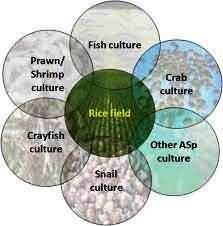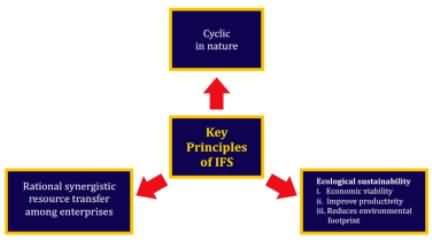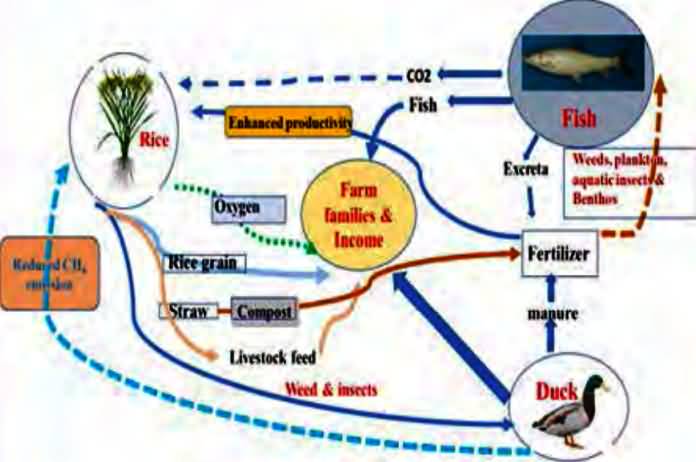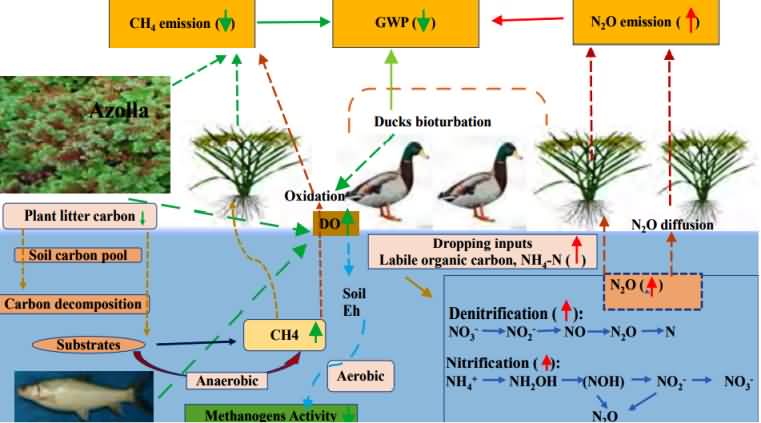एकीकृत चावल और पशुधन खेती
In the scenario of declining trend of availability of land for agriculture and size of land holding, one of the serious threats to our national food security is providing food security to our growing population. Diversion of agricultural land for industrialisation restricts horizontal expansion.
Vertical integration of land based enterprises within the socio-economic environment of small and marginal farmer is the only option. Integrated farming systems are viewed as a sustainable alternative for enhancing livelihood security of small and marginal farmers.
Objectives of Integrated Farming System:
It includes reversing resource degradation, Stabilising farm income, Efficient soil management, Recycling of farm waste and nutrients, Minimisation of adverse environmental impacts, Sustainability in production.
ICAR -national Rice research Institute has developed need-based IFS technologies which has immense potential for improvement of rural economy due to intensification and integration of crop and allied Enterprises.
Adoption of modern rice-based farming system approach has helped the farmers to understand the interaction and linkage of different farm resources which helps in resource recycling and ultimately leads to reduction of input cost and enhancement of productivity and profitability of the system.
Rice (Oryza Sarita L.) is one of the major cereal crops, cultivated in114 countries cross the world (150 million hectares, 11% of total area. About 90 percent of world’s rice is produced and consumed in Asian countries and is mostly cultivated by small and marginal land holders for their livelihood security.

Principles of Integrated Farming System:
ICAR-NRRI has developed crop-livestock-horticultural and agroforestry-based IFS (CLAIFS). The system integrates improved rice varieties, vegetables, fruit crops, agroforestry, floriculture, apiculture, fish, prawn, poultry, duckery, goatry. This system provides greater scope for diversification and climate resilience along with increase in farm productivity, income and sustainability.

Integrated Rice-Livestock-Fish farming
Integrated Rice-Livestock-Fish farming aims at enhancing farm productivity from a limited area and reducing risk by diversifying crops and provisioning of water harvesting through the pond and seepage area etc. This includes Rice- ornamental fish culture, Crop-livestock-agroforestry based IFS for lowland rice ecologies, Rice-fish-duck IFS, Rice –fish –azolla –duck IFS, Multitier rice-fish horticulture-based IFS, Rice based IFS under irrigated condition.
Crop-Livestock-Agroforestry Integrated System:
This system provides greater scope for diversification and climate resilience along with increase in farm productivity, income and sustainability.
Poultry husbandry practices:
The chick varieties either meat type (broiler), egg type (layer) or both mixed types depend on farmer choice. The breeds of Rhode Island, Leghorn, Black rock and Vanraja are suitable. They are reared in rice-based farming system by providing supplementary poultry feed, waste rice, chaff rice including other vegetable wastes etc.
Goat husbandry practices:
The Black Bengal Goat breed is suitable for rice based lowland farming system because they can adopt themselves with almost all types of climates easily. Growing suitable agroforestry species (subabul, babul, shevari etc.) and green fodder (grasses, legume and lobia) with goat rearing will be profitable by providing adequate fodder and saving the concentrated feed cost.
Rice–Fish-Duck Integrated Farming System Technology:
The rice-fish duck IFS (RFD-IFS) provides maximum synergy and utilization of available resources benefitting small and marginal farmers. Duck varieties Indian Runner, Khaki campbell, White pekinor indigenous local ducks, stocking density of @ 200- 250 numbers (10:1, female and male) are suitable for rice fish duck integration.
Ducks may be allowed to forage in the rice fields during the day times. Duck fed mostly on duck weeds (Lemna, Wolfia, Azollaetc.), aquatic weeds available in rice fields. Duck also consumes tadpoles, juvenile frogs, dragon fly larvae and various other organic materials available in the rice environments.
Recycling of nutrients and energy flow in Rice-Fish-Duck:

Rice-Fish-Azolla -duck Integrated Farming System:
Azolla is a free-floating aquatic fern, and naturally available mostly on moist soil, ditches and marshy ponds. It has nitrogen fixing capabilities. The integration of duck, fish and azolla in the rice field creates symbiotic relationship.
Rice-fish, duck and azolla provides mutual benefits to all the entities. The ducks and fish bioturbation (rapid movement) and presence of azolla in the rice ecosystem enhances the concentration of dissolve oxygen in water, resulting aerobic conditions, which decreased methanogens bacterial activity and subsequently decreases the GHG emissions.
Azolla in the rice fields provides substantial amount of nitrogen for rice growth and reduces weed infestations.
Mechanism frame work in reduction of Global warming potential

Impact Analysis of Integrated Farming Systems:
The integrated farming system comprising of the rice-fish-duck (RFD) was found to be more energy efficient as compared to conventional mono cropping system of rice farming (RMC). Rainwater harvesting, conservation and judicious use of existing available water resources can improve the water productivity.
The rice-fish based integrated farming system models provides a provision of rain water harvesting, storage and conservation of water that ensures higher water productivity (WP), gross water productivity (GWP) and net water productivity (NWP) as compared to conventional system. In the integrated farming system, inclusion of fish and duck decreases the weed density and enhances weed control efficiency.
Rice-fish integrated systems are helpful for mitigation of emissions of different greenhouse gases. Improved crop-livestock integration and integrated manure management practices can improve the efficiency of nutrient utilization; reduce the need to import nutrients from outside the farm; and decrease emissions from crop production.

Biodiversity improvements:
Agro-biodiversity maintenance directly influences the productivity and can perform several ecosystem services to agriculture, thus reducing dependence on environmental externalities as well as off-farm inputs. Therefore, integrated farming system is considered as eco-efficient and environment-friendly agriculture which provides important environmental Biodiversity improvements.
Advantages such as reducing the use of harmful chemicals and their spread in the environment and food chain, reducing water use, as well as reducing carbon and ecological footprints. Integrated farming seems to be capable of producing sufficient yield by maintaining crop-livestock diversities (FAO, 2000) and sustainability, as compared to conventional agriculture (FAO, 2012).
Future thrusts:
Refinement and on-farm testing of developed modules in accordance of farmer’s needs and socially acceptable systems. Creation of database on IFS: Enterprise selection, type and size of IFS, resource allocation, economics and sustainability in IFS under different agro-ecological zone.
Waste utilization, recycling of organic resources in the form of plant and animal wastes needs special emphasis. Capacity building for harnessing the benefit of specialized components (rice, fish, livestock, and horticulture etc.), training requirements of rural farmers needs to be suitably addressed.
Integrated crop-livestock-agroforestry systems could foster crop diversity, synergy and mutual benefits between enterprising components with profitability and sustainability. These systems are climate-resilient, eco-efficient and less labor intensive which relies on waste recycling with lesser dependence of non-renewable resource.
The need for diversification of farming practice is thereby needed as the income of farmers who depend solely on the produce of their traditional mono crop of rice pattern is decreasing due to limited profit margin and changed food consuming habits.
These systems are having potentials for climate change resilience and mitigation potentials and thus enables the farmer’s participation in climate risk management for building a climate resilient production system.
Authors:
Dr. Rishi Nanda*, Dr. lipika Sarma, Dr. Amit Kumar, Rahul Kesharwani
Physiology & Climatology Division, ICAR-Indian Veterinary Research Institute, Izatnagar, Bareilly, 243122, Uttar Pradesh, India.
*email id:
